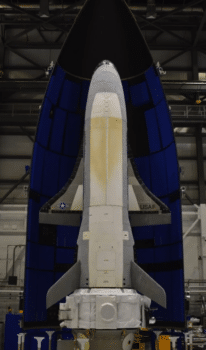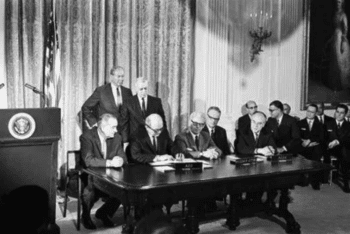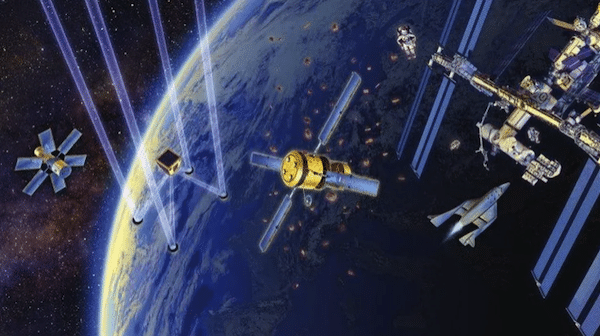
[Source: spacenews.com]
Franklin dates the infatuation to the era of the revolutionary war with the development of the combat submarine by Robert H. Fulton to pulverize the British Navy.
He in turn shows a direct line through World War I and World War II and the development of air power and the atomic bomb, through the Vietnam War where sophisticated U.S. war machines could not defeat the guerrilla warfare tactics of the Vietcong.

[Source: halkudeck.com]
These include space-based satellites and sensors that have been used by the Ukrainians to track Russian troop movements and assist in navigation, mapping and electronic warfare, and positioning systems that guide precision weapons and drones.
A webinar in mid-July hosted by the War Industry Resistance Network placed the U.S. strategy in Ukraine in the context of a broader attempt by the U.S. to militarize space and use it to destroy its leading geopolitical rivals—Russia and China.
The first speaker, Dave Webb, a retired engineering and peace studies professor from England, emphasized that the 1991 Operation Desert Storm set the groundwork for Ukraine as the first space war in which the U.S. showed off new satellite and precision guided missiles that wound up devastating Iraq.

[Source: rev.com]
By 2024, the budget of the Space Force reached $30.3 billion, a 15% increase over 2023 and a doubling of the budget from 2020.
Congress has in a not so veiled way tried to legitimate these budget increases by holding hearings raising alarm about the threat of Unidentified Flying Objects (UFO’s).
One in late July featured a former intelligence officer, David Grusch, who claimed that he faced retaliation at the Pentagon for his confidential disclosure that “non-human beings” had been retrieved from spacecraft.1

David Grusch [Source: people.com]
Space.com reported that the U.S. Space Force has conducted multiple training exercises to practice “live fire” satellite jamming [of Russian and Chinese space based satellites] and “simulated on-orbit combat training” as part of a growing commitment to space-based war.
The Space Force’s operations have been made possible by a $1.5 billion space surveillance radar center built by Lockheed Martin in an atoll in the Marshall Islands, which became operational in March 2020. The center now tracks more than 26,000 objects in space, some the size of a marble.
Additional surveillance centers have recently been built in Texas, Australia and Great Britain while Boeing is building a secret military space plane, the X-37B, which can carry out orbital space flight missions.

The patch of the 75th Intelligence, Surveillance and Reconnaissance Squadron revealed at the unit’s activation ceremony on Aug. 11, 2023. It features the grim reaper with a delta shape for a nose. [Source: space.com]
Space exploration is giving way to space exploitation and growing competition with Russia, which has developed its own space-based weapon systems in response to what the U.S. is doing.
The second speaker at the webinar, Bruce Gagnon, coordinator of the Global Network Against Weapons & Nuclear Power in Space, pointed out that, for the last quarter century, Russia has presented its demand for a new cooperative space treaty before the United Nations but has been blocked by the U.S., Israel and a few of their allies.
The Russians have stated unequivocally, as have the Chinese, that they do not want to devote their countries’ resources to a destructive and fruitless arms race in space, though the U.S. believes it can be master in space and has been taken over totally by the military-industrial complex.

Boeing X-37. [Source: wikipedia.org]
Growing up in a military family, Gagnon said he experienced a political awakening while enlisted in the Air Force in 1971 when he came in contact with peace activists at Travis Air Force Base in Fairfield, California, where he was stationed.
Gagnon’s concern about the militarization of Outer Space began when he read a book by Linda Hunt called Secret Agenda, which detailed the CIA’s recruitment of Nazi scientists under Operation Paperclip who helped found the U.S. space program.
Chief among them was Wernher von Braun, who had helped develop the V-2 rocket in Germany using slave labor.
Gagnon said he finds it chilling that the U.S. Space Force carries out yearly war-game exercises where they simulate fighting using space-based weapons right out of science fiction novels. Among these is the “Rod from God,” a weapon in which tungsten steel rods are fired from orbiting satellites, smacking the Earth from the sky as if sent by God.
Right now, Gagnon says, we are living through a Cuban Missile Crisis in reverse as the U.S. has pointed nuclear weapons directly at Russia from a U.S. military base in Deveselu, Romania, and another in Redzikowo, Poland off the Baltic Sea.

Signing of the Outer Space Treaty in 1967. [Source: spaceflight.com]
Along with World War III, the current U.S. space strategy is threatening to unleash a major environmental catastrophe as space-based satellites and weapons are leaving debris that cannot be cleaned up.
According to Gagnon, exhaust from escalating numbers of rocket launches is diminishing the ozone layer, and the growing space debris could even cause the Earth to go dark as collisions become more likely.
Back in 1989, Gagnon organized a protest at the Kennedy Space Center at Cape Canaveral that was attended by Navy Captain Edgar Mitchell, the only astronaut known to have ever attended a peace rally.2

Rods from God. [Source: wearethemighty.com]
if there was ever a war in space, it would be the last war humans ever fought because it would create so much debris orbiting around the planet, there would be no way to clean it up.
Mitchell’s warning makes clear the importance of supporting the efforts of peace groups to try to prevent the militarization of space and to fight the military-industrial complex, which is a cancer not only to our own planet but to the entire universe.
Notes:
- ↩The disclosure it should be noted was based on second-hand information.
- ↩Born in Hereford, Texas, in 1930, Mitchell obtained a Doctor of Science degree (equivalent to a Ph.D.). from MIT and was the Lunar Module Pilot for the 1971 Apollo 14 mission who was the sixth man to walk on the moon. During his travels to space, Mitchell said that he had an epiphany that led him to work for the rest of his life to “broaden the knowledge of the nature and potentials of mind and consciousness and to apply that knowledge to the enhancement of human well-being and the quality of life on the planet.”

